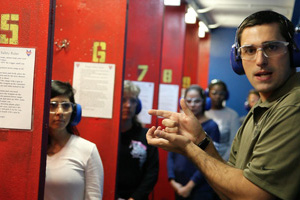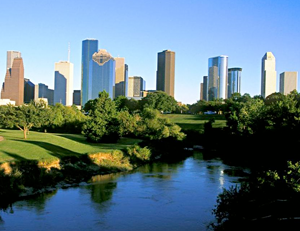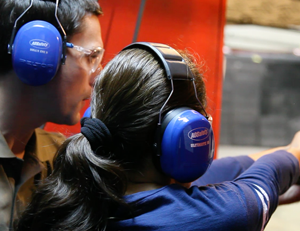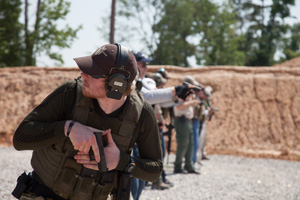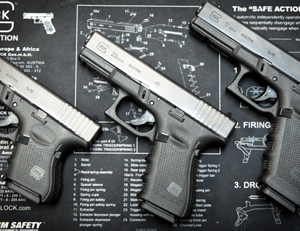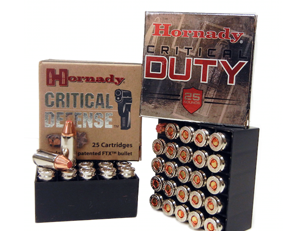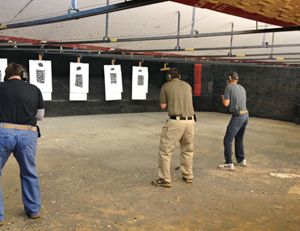
16
TWO MAN SHOOTING SKILLS
I recognize there is a large number of citizens who have taken training beyond the basics required by their state for a concealed carry license. Citizens have taken courses on concealed carry tactics, they have practiced live fire draws from concealment, and some understand cover and concealment. Smart citizens know the limits of their own skills and the limits of their everyday carry weapon (limited number of rounds, maybe a spare magazine, maybe not). Trained citizens have solutions in mind for a number of critical incidents; the ATM robber, the home invasion and maybe the active shooter at work or in a commercial environment. These training courses are often labeled advance pistol or pistol tactics. At 360 Tactical Training, one of our top requested courses is Citizen Response to Active Shooter (CRAS). This course requires that you know how to shoot safely, and reload prior to attending. Our CRAS is a solution and footwork course, showing you what to do and how to work with your competent armed friend who is with you when trouble srikes. Two is better than one for sure, and two people trained to work as a unit is exponentially better. We have a few guiding principles to keep in mind when shooting and when shooting as part of a team.
One: We shoot better when we stand still.
Two: It is a crowded world out there. We are going to bump into thing and into each other, but as long as our muzzles are even, we can both shoot. Do not shoot from behind your partner when in close proximity to each other.
Three: Most of our defensive shooting is to break contact with the bad guy; in essence fighting our way out of danger and to safety.
Four: In the rare event we need to move toward the assailant or assailants, look to flank the bad guy or bad guys.
I like the following drills to prepare citi- zens to work as a two-person team during a critical incident. You should remember when training,it is not about speed,it is about learning to do the skill (foot work/weapon handling) precisely and safely. Speed will come, but practice slowly so your mind develops a blue print of the best solution for it to Google up and present to you in the event of a dynamic critical incident.
IT’S A CROWDED WORLD DRILL:
On a standard firing line, you and your friend stand about arm’s distance away from each other.We like to take a step to get off the X when drawing the weapon, but stand still and shoot. On the “threat” command, both shoot- ers step left.Your left foot must take an overly large lateral step, as your right foot lands, placing you in a good shooting stance, your arms should reach full extension and you should fire two or three rounds.We reset and now go to the right. Cues for this drill are: on command of “threat” you “step” and then “place” then second foot, as you place, the arms reach full extension and the split second you have stopped moving you are shooting. Once you have this down, you can step either way (your choice) on the threat command.The key is when you and your team mate bump in to each other’s shoulders, as long as the end of the weapon is even, you can both shoot.If not,the person whose muzzle is not on the line, so to speak, cannot fire, but must step away and then fire.We cannot fire with our muzzle behind another shooter as the blast that exits the weapon can harm our partner—especially if you are shooting a compensated weapon. If you were way behind the other shooter (as could happen in a real incident), the shooter in front of you may in fact move into your line of fire, so, in the initial response, if not even, you cannot shoot. You must step to a location where you are even and then engage target.
THREE WAYS TO MOVE WITH A GUN:
First method, your hand on your weapon with it still holstered. We call this, staged. If your thoughts start with, “I think”,“it might be”,“I am not sure”, “could be gunfire”, then leave your gun in the holster, hand staged. You will be well positioned if you need your gun, but you will bring minimal attention to yourself should it not be gunfire. The drill starts at the 25-yard line. Walking forward with your friend an arm length away from you, hand staged. On the “threat” command, stop walking, lateral step and shoot two rounds. As in the previous drill, it is a crowded world. Only shoot when muzzles are even. Second method is walking with your weapon at the position Max Joseph termed: Sul. You are sure there has been gunfire and you are now on the move. Position Sul is like a modified high compressed ready. The pistol is held parallel to your sternum, muzzle pointed straight down (in front of toes), support hand under the weapon and thumbs make a box. Some will raise the elbow but here we are trying to blend in, so I keep my elbows along my body. The benefit is that the muzzle is not prematurely pointed at anybody (bystanders), it is difficult to take the gun away, but provides quick presentation. When you go to shoot, the muzzle raises to the target as the hands come together in high compressed ready. The drill starts at the 25-yard line. Walking forward with your friend an arm length away from you, hands staged. On the “threat” command, stop walking, lateral step and shoot two. As in the previous drill, it is a crowded world. Only shoot when muzzles are even. I like to do this drill several times with magazine reloads as needed.When the shooters reach the one-yard line, return to Sul and walk up range to the 25 and begin again. The final method is to SPEAR your way through a crowd. Borrowing a technique inspired by Tony Blauer’s defensive tactics, hold your support arm out like an angled snowplow blade, hold the gun at a one-handed Sul. If you need to shoot, bring the support hand to your chest and then engage from the high compressed as needed. Go slow. Your support hand comes to the chest and the fingers are pointed straight down range, the muzzle never covers any part of your body. After a few reps standing still and transitioning to a two-handed grip then shooting you can again move to the 25 and walk forward as with the other two drills.
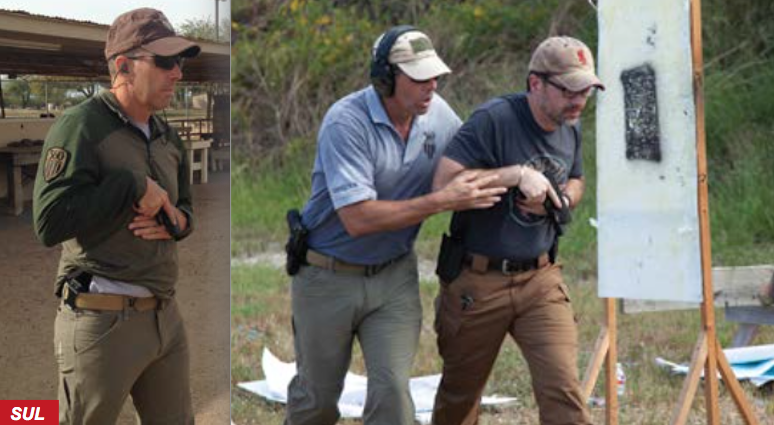
I will use the following terms in the next drills:
Contact: front, left, right, rear. Contact lets your team know you see the bad guy, and then from what direction.This is also used by police and others to designate who will go hands on with the bad guy.The person who is covering must always be able to engage with deadly force, the contact person gives all verbal commands and goes hands on the bad guy for cuffing or searching.
Covering: The act of a person watching or watching for the bad guy. An example, you hear shooting but not sure exactly where it is coming from, you watch the general direc- tion, covering, while your team mate moves. You might be shooting at the bad guy, cover- ing, while your team mate moves to flank the bad guy for a better shot.
Moving: Lets your team mate know you are moving to a new location. Upon arrival you will cover for them to move.
Once we can move with our gun using several methods, we add some footwork. Once we learn where the bad guy is, as team mates we want to create some distance between us and the bad guy or make the bad guy have to engage us each individually, rather than both of us at one location.This gives us the advantage, taking back initiative. This starts the ground work for us to “break contact” or leave the area, or if needed; because it is in our work place or our family is between us and the bad guy we are now setting up to flank the bad guy. Either way, one of us stands still and “covers” the other’s movement. Covering can be engaging the suspect with controlled fire if we are able to engage the bad guy, or just watching in the direction of the potential contact.
BREAK CONTACT DRILL:
This can be used with two shooters or one shooter evacuating unarmed persons. Both shooters start at the same location. For safety, the shooter on the right side will engage a target well out to the right, I like to paint it green to limit confusion.The left side shooter engages a target well out to the left side, painted red. Each shooter can only shoot their predesignated target. On command of “threat or contact” each shooter draws and shoots their target two times.In the pause,(as the instructor,I usually predesignate who will move first) one shooter yells,“moving.” The other replies,“covering”and fires at the target at a slow pace.The mover goes to the next barricade and yells, “covering” while their finger is straight and off the trigger, but pointed at the target, for this example the green side (right) moved first, so he will always bound out turning to the right and the left or red always turns left,this avoids crossing your team mate’s line of fire.This is a drill for bounding out of contact using objects that provide cover or concealment that are in a single file line. Version two is to have lines of objects that they can bound out using as cover with a single threat in the center or threat to the side. Version three, one bad guy with four barricades on line and the shooters bound from left to right or right to left.
FLANKING:
As you will see on far too many police shoot- ing videos, the bad guy is in a covered po- sition, shooting it out with the cops who bunch up in the same area and shoot back. The result is a lot of rounds fired by friend- lies and few hits. To win faster with fewer rounds fired, we need to work on flanking the bad guys while using the same concepts as bounding to break contact, but this time moving forward.This would be used to de- feat an active shooter in the work place or the situation where you need to move for- ward because a family member is between you and the bad guy and you cannot break contact and leave them behind. The setup for this drill is, you can only see the arm of the bad guy shooting at you, simulated by us- ing a three-inch black circle.Then as shooter one engages the suspect, the second shooter moves away at an angle and forward. Upon arrival at the barricade, the shooter engages and yells, “covering”, the first shooter then bounds past the second to position three. I like to use a mannequin as a target for this drill. It helps shooters get a real perspective on how much more they can see if they flank the bad guy and stop just punching it out toe to toe.
Shooters first need safe gun handling skills and proficiency in operating their firearms. If guns are to be used for defense, then tactical thought and training must be conducted. Any time you can confront a critical incident as a competent team rather than as an individual, it is to your benefit. The 360 CRAS course is an opportunity to practice some of those skills, but no matter where you train, train safely and check local laws to make sure your defensive plans are legal.
BIO
Kent O’Donnell is a former Recon Marine and a retired police sergeant. He spent most of his career on his department’s SWAT team. Kent has done risk and security audits and training throughout west Africa, South America and Europe and provided weap- ons and tactics training around the world. Kent worked on a U.S. government project in Libya for six months and currently works as an instructor and operator for 360 Tactical Training and 360 Worldwide Security.

16
TWO MAN SHOOTING SKILLS
I recognize there is a large number of citizens who have taken training beyond the basics required by their state for a concealed carry license. Citizens have taken courses on concealed carry tactics, they have practiced live fire draws from concealment, and some understand cover and concealment. Smart citizens know the limits of their own skills and the limits of their everyday carry weapon (limited number of rounds, maybe a spare magazine, maybe not). Trained citizens have solutions in mind for a number of critical incidents; the ATM robber, the home invasion and maybe the active shooter at work or in a commercial environment. These training courses are often labeled advance pistol or pistol tactics. At 360 Tactical Training, one of our top requested courses is Citizen Response to Active Shooter (CRAS). This course requires that you know how to shoot safely, and reload prior to attending. Our CRAS is a solution and footwork course, showing you what to do and how to work with your competent armed friend who is with you when trouble srikes. Two is better than one for sure, and two people trained to work as a unit is exponentially better. We have a few guiding principles to keep in mind when shooting and when shooting as part of a team.
One: We shoot better when we stand still.
Two: It is a crowded world out there. We are going to bump into thing and into each other, but as long as our muzzles are even, we can both shoot. Do not shoot from behind your partner when in close proximity to each other.
Three: Most of our defensive shooting is to break contact with the bad guy; in essence fighting our way out of danger and to safety.
Four: In the rare event we need to move toward the assailant or assailants, look to flank the bad guy or bad guys.
I like the following drills to prepare citi- zens to work as a two-person team during a critical incident. You should remember when training,it is not about speed,it is about learning to do the skill (foot work/weapon handling) precisely and safely. Speed will come, but practice slowly so your mind develops a blue print of the best solution for it to Google up and present to you in the event of a dynamic critical incident.
IT’S A CROWDED WORLD DRILL:
On a standard firing line, you and your friend stand about arm’s distance away from each other.We like to take a step to get off the X when drawing the weapon, but stand still and shoot. On the “threat” command, both shoot- ers step left.Your left foot must take an overly large lateral step, as your right foot lands, placing you in a good shooting stance, your arms should reach full extension and you should fire two or three rounds.We reset and now go to the right. Cues for this drill are: on command of “threat” you “step” and then “place” then second foot, as you place, the arms reach full extension and the split second you have stopped moving you are shooting. Once you have this down, you can step either way (your choice) on the threat command.The key is when you and your team mate bump in to each other’s shoulders, as long as the end of the weapon is even, you can both shoot.If not,the person whose muzzle is not on the line, so to speak, cannot fire, but must step away and then fire.We cannot fire with our muzzle behind another shooter as the blast that exits the weapon can harm our partner—especially if you are shooting a compensated weapon. If you were way behind the other shooter (as could happen in a real incident), the shooter in front of you may in fact move into your line of fire, so, in the initial response, if not even, you cannot shoot. You must step to a location where you are even and then engage target.
THREE WAYS TO MOVE WITH A GUN:
First method, your hand on your weapon with it still holstered. We call this, staged. If your thoughts start with, “I think”,“it might be”,“I am not sure”, “could be gunfire”, then leave your gun in the holster, hand staged. You will be well positioned if you need your gun, but you will bring minimal attention to yourself should it not be gunfire. The drill starts at the 25-yard line. Walking forward with your friend an arm length away from you, hand staged. On the “threat” command, stop walking, lateral step and shoot two rounds. As in the previous drill, it is a crowded world. Only shoot when muzzles are even. Second method is walking with your weapon at the position Max Joseph termed: Sul. You are sure there has been gunfire and you are now on the move. Position Sul is like a modified high compressed ready. The pistol is held parallel to your sternum, muzzle pointed straight down (in front of toes), support hand under the weapon and thumbs make a box. Some will raise the elbow but here we are trying to blend in, so I keep my elbows along my body. The benefit is that the muzzle is not prematurely pointed at anybody (bystanders), it is difficult to take the gun away, but provides quick presentation. When you go to shoot, the muzzle raises to the target as the hands come together in high compressed ready. The drill starts at the 25-yard line. Walking forward with your friend an arm length away from you, hands staged. On the “threat” command, stop walking, lateral step and shoot two. As in the previous drill, it is a crowded world. Only shoot when muzzles are even. I like to do this drill several times with magazine reloads as needed.When the shooters reach the one-yard line, return to Sul and walk up range to the 25 and begin again. The final method is to SPEAR your way through a crowd. Borrowing a technique inspired by Tony Blauer’s defensive tactics, hold your support arm out like an angled snowplow blade, hold the gun at a one-handed Sul. If you need to shoot, bring the support hand to your chest and then engage from the high compressed as needed. Go slow. Your support hand comes to the chest and the fingers are pointed straight down range, the muzzle never covers any part of your body. After a few reps standing still and transitioning to a two-handed grip then shooting you can again move to the 25 and walk forward as with the other two drills.

I will use the following terms in the next drills:
Contact: front, left, right, rear. Contact lets your team know you see the bad guy, and then from what direction.This is also used by police and others to designate who will go hands on with the bad guy.The person who is covering must always be able to engage with deadly force, the contact person gives all verbal commands and goes hands on the bad guy for cuffing or searching.
Covering: The act of a person watching or watching for the bad guy. An example, you hear shooting but not sure exactly where it is coming from, you watch the general direc- tion, covering, while your team mate moves. You might be shooting at the bad guy, cover- ing, while your team mate moves to flank the bad guy for a better shot.
Moving: Lets your team mate know you are moving to a new location. Upon arrival you will cover for them to move.
Once we can move with our gun using several methods, we add some footwork. Once we learn where the bad guy is, as team mates we want to create some distance between us and the bad guy or make the bad guy have to engage us each individually, rather than both of us at one location.This gives us the advantage, taking back initiative. This starts the ground work for us to “break contact” or leave the area, or if needed; because it is in our work place or our family is between us and the bad guy we are now setting up to flank the bad guy. Either way, one of us stands still and “covers” the other’s movement. Covering can be engaging the suspect with controlled fire if we are able to engage the bad guy, or just watching in the direction of the potential contact.
BREAK CONTACT DRILL:
This can be used with two shooters or one shooter evacuating unarmed persons. Both shooters start at the same location. For safety, the shooter on the right side will engage a target well out to the right, I like to paint it green to limit confusion.The left side shooter engages a target well out to the left side, painted red. Each shooter can only shoot their predesignated target. On command of “threat or contact” each shooter draws and shoots their target two times.In the pause,(as the instructor,I usually predesignate who will move first) one shooter yells,“moving.” The other replies,“covering”and fires at the target at a slow pace.The mover goes to the next barricade and yells, “covering” while their finger is straight and off the trigger, but pointed at the target, for this example the green side (right) moved first, so he will always bound out turning to the right and the left or red always turns left,this avoids crossing your team mate’s line of fire.This is a drill for bounding out of contact using objects that provide cover or concealment that are in a single file line. Version two is to have lines of objects that they can bound out using as cover with a single threat in the center or threat to the side. Version three, one bad guy with four barricades on line and the shooters bound from left to right or right to left.
FLANKING:
As you will see on far too many police shoot- ing videos, the bad guy is in a covered po- sition, shooting it out with the cops who bunch up in the same area and shoot back. The result is a lot of rounds fired by friend- lies and few hits. To win faster with fewer rounds fired, we need to work on flanking the bad guys while using the same concepts as bounding to break contact, but this time moving forward.This would be used to de- feat an active shooter in the work place or the situation where you need to move for- ward because a family member is between you and the bad guy and you cannot break contact and leave them behind. The setup for this drill is, you can only see the arm of the bad guy shooting at you, simulated by us- ing a three-inch black circle.Then as shooter one engages the suspect, the second shooter moves away at an angle and forward. Upon arrival at the barricade, the shooter engages and yells, “covering”, the first shooter then bounds past the second to position three. I like to use a mannequin as a target for this drill. It helps shooters get a real perspective on how much more they can see if they flank the bad guy and stop just punching it out toe to toe.
Shooters first need safe gun handling skills and proficiency in operating their firearms. If guns are to be used for defense, then tactical thought and training must be conducted. Any time you can confront a critical incident as a competent team rather than as an individual, it is to your benefit. The 360 CRAS course is an opportunity to practice some of those skills, but no matter where you train, train safely and check local laws to make sure your defensive plans are legal.
BIO
Kent O’Donnell is a former Recon Marine and a retired police sergeant. He spent most of his career on his department’s SWAT team. Kent has done risk and security audits and training throughout west Africa, South America and Europe and provided weap- ons and tactics training around the world. Kent worked on a U.S. government project in Libya for six months and currently works as an instructor and operator for 360 Tactical Training and 360 Worldwide Security.

